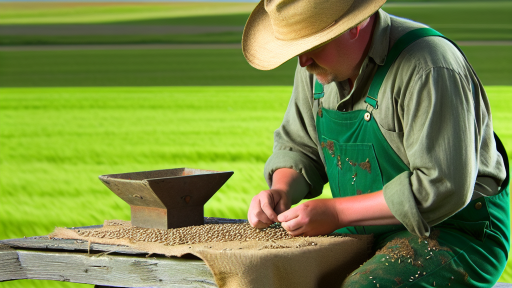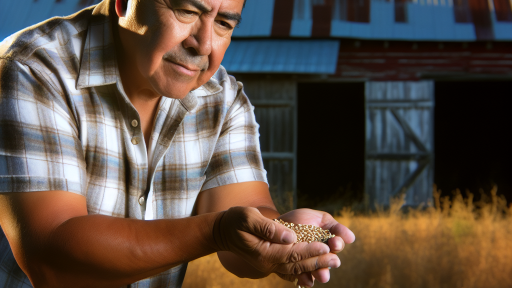Understanding the Importance of Seed Rotation in Sustainable Agriculture
Enhancing Soil Health
Seed rotation improves soil health significantly.
It prevents the depletion of specific nutrients.
This practice promotes a balanced ecosystem.
Moreover, diverse crops contribute to soil structure.
Healthy soil supports better plant growth.
Reducing Pest and Disease Pressure
Alternating crops interrupts pest life cycles.
This strategy reduces the likelihood of disease outbreaks.
Crops vulnerable to certain pests can be rotated out.
Consequently, maintaining a healthy farm ecosystem becomes easier.
Improving Crop Yields
Crop rotation enhances overall yields over time.
Diverse plantings lead to more productive harvests.
This practice helps combat soil-borne diseases.
As a result, farmers can achieve higher profitability.
Encouraging Biodiversity
Seed rotation promotes biodiversity in agriculture.
Diverse crops encourage beneficial insects and microorganisms.
Transform Your Agribusiness
Unlock your farm's potential with expert advice tailored to your needs. Get actionable steps that drive real results.
Get StartedThis balance helps pest control naturally.
Ultimately, it supports a thriving agricultural environment.
Meeting Regulatory and Market Demands
Many markets now prioritize sustainable practices.
Seed rotation can help meet these standards easily.
It enhances the reputation of agricultural producers.
This commitment can lead to better market opportunities.
Identifying Compatible Crops for Effective Seed Rotation
Understanding Crop Compatibility
Crop compatibility plays a vital role in seed rotation strategies.
Growing compatible crops prevents pest and disease build-up.
Additionally, it enhances soil fertility and nutrient cycling.
Selecting Vegetables for Rotation
When selecting vegetables, consider their growth habits and nutrient needs.
Legumes are excellent choices as they fix nitrogen in the soil.
Root vegetables, like carrots and beets, can follow legumes effectively.
Brassicas, including cabbage and kale, thrive well after legumes.
Selecting Grains and Cover Crops
Grains such as corn and wheat serve as effective rotation options.
These crops benefit from alternating with broadleaf plants.
Furthermore, cover crops like clover provide crucial soil benefits.
They improve soil structure and prevent erosion.
Avoiding Crop Families
It’s essential to avoid planting the same crop family consecutively.
This practice limits the risk of disease and pest proliferation.
For example, avoid planting tomatoes after peppers, as they share pests.
Instead, rotate with unrelated crops to break pest cycles.
Using Resources for Planning
Utilize planting guides and crop rotation charts for your region.
These resources provide insights on compatible crops.
In addition, local agricultural extensions offer tailored advice.
Showcase Your Farming Business
Publish your professional farming services profile on our blog for a one-time fee of $200 and reach a dedicated audience of farmers and agribusiness owners.
Publish Your ProfileNetworking with experienced growers can also provide valuable information.
Analyzing Soil Health and Nutrient Needs for Seed Rotation Planning
Understanding Soil Health
Soil health is crucial for successful crop production.
Healthy soil supports vibrant plant growth.
Moreover, it is essential for sustaining agricultural ecosystems.
Assessing soil health incorporates various factors.
These include organic matter content, pH levels, and soil structure.
Additionally, the presence of beneficial microorganisms influences soil vitality.
Regular soil testing provides valuable insights into these parameters.
Identifying Nutrient Needs
Each crop has specific nutrient requirements for optimal growth.
Understanding these needs is essential for effective rotation planning.
For example, legumes fix nitrogen in the soil, enriching nutrient levels.
This process benefits subsequent crops like corn or wheat.
Consequently, incorporating nitrogen-fixing crops improves soil fertility.
Furthermore, balancing nutrient availability is vital to plant health.
Evaluating Crop Rotation Benefits
Crop rotation enhances soil health by disrupting pest cycles.
It also helps manage nutrient depletion caused by monoculture.
By diversifying crops, farmers can improve soil structure and composition.
Additionally, rotating different plant families minimizes disease spread.
This strategy ultimately leads to higher yields and healthier plants.
Planning for Future Seasons
Effective seed rotation requires thoughtful planning.
Farmers should consider historical crop performance data.
Evaluating past rotations reveals successful practices and failures.
Moreover, future weather patterns can impact crop choices.
Predictive models help in selecting appropriate crops based on trends.
Preparing for potential challenges enhances resilience in farming practices.
Find Out More: Cost-Effective Aquaponics Setup Tips
Crafting a Seasonal Calendar for Crop Rotation
Importance of a Seasonal Calendar
A seasonal calendar is key for effective crop rotation.
It helps plan planting and harvesting schedules.
Moreover, it ensures that soil nutrients are replenished.
By rotating crops, farmers reduce pest and disease risks.
Identifying Crops for Rotation
Selecting diverse crops is crucial for a healthy rotation.
Include legumes to enrich soil nitrogen levels.
Root vegetables help break up compacted soil structures.
Consider crops that thrive in different seasons.
This diversity enhances resilience and productivity.
Mapping Out the Schedule
Create a visual representation of the cropping schedule.
Use software or simple charts to illustrate plans.
Clearly mark planting and harvesting dates for each crop.
Incorporate timings for soil preparation and recovery periods.
Regular updates will keep the schedule relevant and effective.
Showcase Your Farming Business
Publish your professional farming services profile on our blog for a one-time fee of $200 and reach a dedicated audience of farmers and agribusiness owners.
Publish Your ProfileAdapting to Local Climate and Conditions
It’s essential to adjust the calendar to local conditions.
Research local climate patterns to forecast suitable planting times.
Monitor soil health and adjust crop choices accordingly.
Engage with local agricultural extension services for insights.
Reviewing and Adjusting the Plan
Continuously evaluate the effectiveness of your seasonal calendar.
Analyze yields and make adjustments based on the data.
Seek feedback from fellow farmers to identify improvement areas.
Flexibility is critical to adapting to unforeseen challenges.
See Related Content: Edible Landscaping for Soil Health
Incorporating Cover Crops for Improved Soil Structure and Fertility
Understanding Cover Crops
Cover crops are plants grown primarily for soil health benefits.
They protect the soil from erosion and improve its structure.
Moreover, they enhance fertility by adding organic matter to the soil.
Types of Cover Crops
Several types of cover crops can benefit different soil types.
- Legumes fix nitrogen and improve soil fertility.
- Cereal grains provide ground cover and prevent erosion.
- Brassicas can break up compacted soil layers.
Benefits of Using Cover Crops
Incorporating cover crops can lead to healthier soils.
They help retain moisture during dry seasons.
Additionally, they suppress weeds and reduce pest pressure.
Best Practices for Planting Cover Crops
Select cover crops based on your specific goals and season.
Plant them early enough to establish root systems before winter.
Ensure proper termination to avoid competition with cash crops.
Monitoring and Adjusting Practices
Regularly assess the performance of your cover crops.
Modify planting and termination strategies based on your findings.
This adaptive approach maximizes their benefits for your soil.
Discover More: Pest Control Strategies For Urban Gardens

Utilizing Pest and Disease Management Strategies within Seed Rotation
Importance of Seed Rotation
Seed rotation plays a crucial role in managing pests and diseases.
By alternating crop varieties, you disrupt pest life cycles.
This practice minimizes disease spread, creating healthier crops.
Moreover, it enhances soil fertility and structure over time.
Identifying Pest and Disease Resistance
Select seed varieties that offer strong resistance to common pests.
Research hybrid options that thrive in your specific climate.
Working with local agricultural experts can provide valuable insights.
Consider planting resistant varieties during the initial rotation phase.
Monitoring and Early Detection
Regularly monitor your crops for signs of pests or disease.
Use traps and visual inspections to assess pest populations.
Early detection is key to managing outbreaks effectively.
Document the presence of any pests to track patterns over time.
Utilizing Companion Planting
Integrate companion planting as a part of your rotation strategy.
Certain plants repel pests naturally and improve soil health.
For example, marigolds deter nematodes and other harmful insects.
This technique complements seed rotation, enhancing overall effectiveness.
Implementing Crop Diversity
Diversifying your crop choices is a powerful management tool.
Showcase Your Farming Business
Publish your professional farming services profile on our blog for a one-time fee of $200 and reach a dedicated audience of farmers and agribusiness owners.
Publish Your ProfileDifferent plant families attract various pests and beneficial insects.
This variety reduces the likelihood of pest infestations.
It also contributes to a balanced ecosystem in your garden or farm.
Adopting Organic Practices
Organic farming techniques promote healthier crops naturally.
Implement biological control methods, such as beneficial insects.
Use organic fertilizers to maintain soil health without chemicals.
These practices further limit pest and disease prevalence in your rotation.
See Related Content: Marketing Heirloom Produce: Tips for Farmers
Evaluating the Economic Benefits of Diverse Crop Rotations
Understanding Crop Rotation
Crop rotation is the practice of growing different crops in the same area over time.
This method enhances soil health and boosts agricultural productivity.
By alternating crops, farmers can reduce pests and diseases.
Moreover, crop rotation can improve the overall balance of nutrients in the soil.
Cost Savings Through Pest Management
Diverse crop rotations help prevent the build-up of pests.
This reduces the reliance on chemical pesticides.
Farmers can save money by decreasing pesticide expenditures.
Long-term, this practice promotes sustainable pest management.
Enhancing Soil Fertility
Different crops contribute various nutrients to the soil.
Leguminous plants, for example, fix nitrogen and enrich the soil.
This natural fertilization reduces the need for synthetic fertilizers.
Consequently, farmers can lower their input costs significantly.
Improving Market Accessibility
Diversity in crops can access different markets and consumers.
This adaptability helps farmers respond to market demands.
By offering a variety of products, farmers can enhance their profitability.
This strategy can also buffer against price fluctuations in any single crop.
Environmental Benefits Leading to Cost Efficiency
Diverse crop rotations improve soil structure and moisture retention.
This leads to better resilience against climate variability.
As a result, farmers experience less crop failure and associated costs.
Over time, these practices contribute to a more sustainable farming economy.
Adapting Seed Rotation Strategies to Local Climate and Geography
Understanding Local Climate
Local climate plays a significant role in determining the best seed rotation strategies.
Temperature patterns influence crop growth cycles effectively.
Thus, farmers must adapt their practices to seasonal changes.
For instance, warmer regions may support quicker growing crops.
Consequently, selecting heat-resistant seeds becomes essential.
Examining Soil Types
Soil composition varies widely across different regions.
Each soil type has unique nutrient profiles that affect crop yield.
Farmers should analyze their soil characteristics regularly.
For example, sandy soils may drain quickly and require frequent watering.
Conversely, clay soils retain moisture longer, impacting crop choice.
Utilizing Local Expertise
Local agricultural experts can offer invaluable insights.
Engaging with these professionals helps farmers make informed decisions.
Showcase Your Farming Business
Publish your professional farming services profile on our blog for a one-time fee of $200 and reach a dedicated audience of farmers and agribusiness owners.
Publish Your ProfileAdditionally, farmers can benefit from attending regional workshops.
These gatherings often discuss effective rotation practices relevant to the area.
Considering Pest and Disease Patterns
Pest populations can fluctuate based on local conditions.
Farmers should monitor these trends to adapt their seed rotation.
For example, certain crops might attract specific pests more than others.
Consequently, rotating crops can disrupt pest life cycles effectively.
Moreover, understanding common diseases in the area aids in crop selection.
Evaluating Market Demands
Market preferences influence crop rotation strategies significantly.
Farmers should keep abreast of local consumer trends.
Growing popular crops can enhance profitability and reduce risks.
Furthermore, adapting to changing tastes ensures sustained market relevance.
Implementing Sustainable Practices
Sustainability is crucial in modern agriculture.
Farmers should consider eco-friendly practices in their rotations.
Using cover crops can enhance soil health and prevent erosion.
Moreover, incorporating organic methods supports biodiversity in farming.
Testing and Adapting Practices
Regularly testing soil and crop performance is essential.
Farmers need to remain flexible and willing to change strategies.
Each season offers new data to refine practices effectively.
Finally, documenting results helps create a comprehensive farming record.
Additional Resources
Cover Crops and Crop Rotation | Home
The Three Sisters of Indigenous American Agriculture | National …




